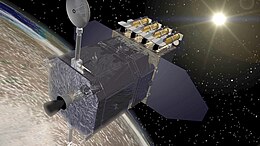സോളാർ ഡൈനാമിക്സ് ഓബ്സർവേറ്ററി
സോളാർ ഡൈനാമിക്സ് ഓബ്സർവേറ്ററി (SDO) സൂര്യനെ കുറിച്ചു പഠിക്കുന്നതിനു വേണ്ടി നാസ വിക്ഷേപിച്ച ഒരു ബഹിരാകാശ പേടകമാണ്.[3] 2010 ഫെബ്രുവരി 11ന് Living With a Star (LWS) പദ്ധതിയുടെ ഭാഗമായാണ് ഇതു വിക്ഷേപിച്ചത്.[4] ഭൂമിയിലും ഭൂസമീപസ്ഥലത്തും സൂര്യനുള്ള സ്വാധീനത്തെ കുറിച്ചു പഠിക്കുന്നതിനും സൂര്യന്റെ അന്തരീക്ഷത്തെ കുറിച്ച് കൂടുതൽ മനസ്സിലാക്കുന്നതിനും വേണ്ടിയാണ് ഈ പേടകം വിക്ഷേപിക്കപ്പെട്ടിരിക്കുന്നത്. സൂര്യന്റെ കാന്തികക്ഷേത്രത്തെ കുറിച്ചും അതിൽ ഉണ്ടാവുന്ന കാന്തികോർജ്ജത്തെയും അതിന്റെ രൂപമാറ്റത്തെയും കുറിച്ചു പഠിക്കുന്നതും SDOയുടെ ഉദ്ദേശ്യമാണ്.[5]
 | |
| സംഘടന | NASA / Goddard Space Flight Center |
|---|---|
| ഉപയോഗലക്ഷ്യം | Orbiter |
| Satellite of | Earth |
| വിക്ഷേപണ തീയതി | 2010-02-11 15:23:00 UTC |
| വിക്ഷേപണ വാഹനം | Atlas V 401 |
| വിക്ഷേപണസ്ഥലം | Space Launch Complex 41 Cape Canaveral Air Force Station |
| പ്രവർത്തന കാലാവധി | 5 - 10 years elapsed: 14 years, 10 months and 15 days |
| COSPAR ID | 2010-005A |
| Homepage | http://sdo.gsfc.nasa.gov |
| പിണ്ഡം | payload: 290 കി.ഗ്രാം (10,000 oz) fuel: 1,400 കി.ഗ്രാം (49,000 oz) total: 3,100 കി.ഗ്രാം (110,000 oz) |
| ഭ്രമണപഥത്തിന്റെ വിശദാംശങ്ങൾ | |
| ഭ്രമണപഥം | Geosynchronous orbit |
| Inclination | 28° |
| Longitude | 102° W |
| Instruments | |
| Spectral band | <.1 nm |
| Data rate | 130 Mbps on the 26 GHz Ka band 150 million bits/second |
| References: [1][2] | |
പൊതുവിവരങ്ങൾ
തിരുത്തുകനാസയുടെ കീഴിലുള്ള ഗൊദാർദ് സ്പേസ് ഫ്ലൈറ്റ് സെന്ററിലാണ് സോളാർ ഡൈനാമിക്സ് ഓബ്സർവേറ്ററിയുടെ നിർമ്മാണവും പരിശോധനയും നടന്നത്. കേപ് കനാവറാൽ എയർഫോഴ്സ് സ്റ്റേഷനിൽ നിന്ന് 2010 ഫെബ്രുവരി 11ന് വിക്ഷേപിച്ചു. ആദ്യത്തെ അഞ്ചു വർഷവും മൂന്നു മാസവും കൊണ്ട് പ്രാഥമിക ദൗത്യം പൂർത്തിയാവും. എന്നാൽ പത്തുവർഷം വരെ പ്രവർത്തിക്കാൻ ഇതിനാവും.[6]
സോളാർ ഡൈനാമിക്സ് ഓബ്സർവേറ്ററിക്ക് രണ്ടു വലിയ സൗരപാനലുകളും ശക്തിയേറിയ രണ്ട് ആന്റിനകളും ഉണ്ട്. എക്സ്ട്രീം അൾട്രാവയലറ്റ് വേരിയബിലിറ്റി എക്സ്പിരിമെന്റ് (EVE), ഹീലിയോസീസ്മിക് ആന്റ് മാഗ്നറ്റിക് ഇമേജർ(HMI) അറ്റ്മോസ്ഫെറിക് ഇമേജിങ് അസംബ്ലി(AIA) എന്നീ ഉപകരണങ്ങളാണ് ഇതിലുള്ളത്.
ഹീലിയോ സീസ്മിക് ആന്റ് മഗ്നറ്റിക് ഇമേജർ (HMI)
തിരുത്തുകസൂര്യന്റെ അന്തർഭാഗത്തെ കുറിച്ചും അതിന്റെ കാന്തിക പ്രവർത്തനങ്ങളെ കുറിച്ചും പഠിക്കുന്നതിനുള്ള ഉപകരണമാണ് ഹീലിയോ സീസ്മിക് ആന്റെ മാഗ്നറ്റിക് ഇമേജർ. ഇത് സ്റ്റാൻഫോർഡ് യൂണിവേഴ്സിറ്റിയിലാണ് നിർമ്മിച്ചത്. സൗരചഞ്ചലതയെ(solar variability) കുറിച്ചുള്ള വിവരങ്ങൾ ഇതിൽ നിന്നും ലഭ്യമാവും. കൂടാതെ ആന്തരിക പ്രവർത്തനങ്ങൾ ഏതു രീതിയിലാണ് സൂര്യന്റെ ബാഹ്യകാന്തിക മണ്ഡലത്തെയും അതിന്റെ പ്രവർത്തനങ്ങളെയും സ്വാധീനിക്കുന്നത് എന്നും മനസ്സിലാക്കാൻ കഴിയും.[7]
അവലംബം
തിരുത്തുക- ↑ Dean Pesnell; Kevin Addison (5 February 2010). "SDO - Solar Dynamics Observatory: SDO Specifications". NASA. Archived from the original on 2010-01-30. Retrieved 2010-02-13.
{{cite web}}: CS1 maint: multiple names: authors list (link) - ↑ "SDO Our Eye on the Sun" (.PDF). NASA. Retrieved 2010-02-13.
- ↑ Bourkland, Kristin L.; Liu, Kuo-Chia. "Verification of the Solar Dynamics Observatory High Gain Antenna Pointing Algorithm Using Flight Data". American Institute of Aeronautics and Astronautics. NASA Technical Reports Server. Retrieved 14 September 2011.
{{cite web}}: CS1 maint: multiple names: authors list (link) - ↑ Justin Ray. "Mission Status Center: Atlas 5 SDO". Spaceflight Now. Retrieved 2010-02-13.
- ↑ Dean Pesnell; Kevin Addison (5 February 2010). "SDO - Solar Dynamics Observatory: About The SDO Mission". NASA. Archived from the original on 2013-11-26. Retrieved 2010-02-13.
{{cite web}}: CS1 maint: multiple names: authors list (link) - ↑ "Solar Dynamics Observatory — Our Eye on the Sky" (.PDF). NASA. Retrieved February 13, 2010.
- ↑ Solar Physics Research Group. "Helioseismic and Magnetic Imager Investigation". Stanford University. Retrieved 2010-02-13.